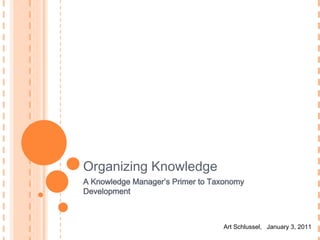
Organizing Knowledge: A Knowledge Manager’s Primer to Taxonomy Development
- 1. Organizing Knowledge A Knowledge Manager’s Primer to Taxonomy Development Art Schlussel, January 3, 2011
- 2. Why Organize Knowledge? ¢ Knowledge organization is a fundamental precondition for managing knowledge effectively. (Lambe, Organising Knowledge 2007) ¢ Taxonomies play an integral role in organizing knowledge.
- 3. What Taxonomies Do ¢ Structure and organize. — Taxonomies organize knowledge and information, as well as work and resources. ¢ Help establish common ground. — Taxonomies provide standardized vocabularies and public, consistent ways of organizing information. ¢ Help span boundaries between groups. — Taxonomies act as boundary objects if they form a common frame of reference for two or more distinctive communities. ¢ Help in sense-making. — Taxonomies can draw our attention to important, actionable, and relevant things. ¢ Aid in the discovery of risk and opportunity. — The process of developing a taxonomy (taxonomy work) helps the organization to recognize its knowledge and information in context.
- 4. Taxonomies are ¢ The science, laws, or principles of classification (thefreedictionary.com) ¢ For the purposes of Knowledge Management (KM) an effective taxonomy has three key attributes: — A taxonomy is a classification scheme — A taxonomy is semantic — A taxonomy is a knowledge map
- 5. Classification Schemes ¢ Classification schemes are designed to group related things together so that if you find one thing within a category it is easy to find other related things in that category. ¢ Classification schemes can be informal and ad-hoc (like organizing your DVD collection) or formal and standardized (like the Dewey Decimal Classification System)
- 6. Semantic ¢ Taxonomies in KM are primarily semantic, meaning they provide a fixed vocabulary to describe their knowledge and information assets (as opposed to codes or numbers) ¢ Taxonomies express the relationships between terms in the taxonomy. ¢ If you take all the labels in a taxonomy and put them in alphabetical order you have a controlled vocabulary. ¢ If you take each term in your controlled vocabulary and describe its relationships with other terms in the taxonomy you get a thesaurus.
- 7. Knowledge Map ¢ A good taxonomy should provide the user an immediate grasp of the overall structure of the knowledge domain, and the ability to accurately anticipate what resources might be found. ¢ The taxonomy should be comprehensive, predictable and easy to navigate. The combined features of classified, semantic, and a knowledge domain map makes a taxonomy act as an artificial memory device
- 8. Taxonomy Work ¢ Taxonomies are products that can be used, however the processes that produce them are more important than the taxonomies themselves because the organization must closely examine its knowledge and information in context. ¢ Taxonomies are comprised of the following work: — Listing, creating and modifying categories of knowledge domains. — Standardizing, mapping, representing and discovering native vocabularies and categories within those domains. — Negotiating common norms across the enterprise.
- 9. Taxonomy Forms ¢ Lists ¢ Matrices — The most basic form and a — Most effective when foundation for more categorizing along two or complex ways of three dimensions. representing taxonomies. ¢ Facets ¢ Trees — A base taxonomy — A command structure that comprising only one of the represents the transition fundamental dimensions in from general to specific or which content can be from whole to part. analyzed. ¢ Hierarchies ¢ System maps — A very specific kind of tree — Visual representations of structure that is consistent knowledge domains where and predictable. proximity and connections between entities are used to express their relationships. There are practical implications of the different taxonomy forms, and it is necessary to know when to use each form, and the issues that can arise from their use
- 10. Taxonomy Project Steps q Step 1 – Meet project sponsor q Step 8 – Facet analysis q Get the sense of purpose and rationale; map the project scope including knowledge domains q Identifying those subject area aspects that and stakeholders resonate with the majority of stakeholders q Step 2 – Engage stakeholders q Step 9 – Test and observe q Validate project map and understand their q Validate the structure (content and design) needs q Conduct a pilot q Step 3 – Refine the project purpose q Get the sponsor’s agreement q Step 10 – Plan the instantiation of your q Step 4 – Design your approach taxonomy q Build or buy; simple or complex; form q Determine the tools needed to support the q Step 5 – Build your communication plan instantiation and anticipate usability issues q Identify the benefits, audience, approach q Step 11 – Integrate the taxonomy into the q Step 6 – Start the process for taxonomy existing infrastructure governance q Plan how and where to infuse the taxonomy; q Governance mechanism is a body of stakeholders involved in design, validation, integrate with KM, Records Management, communications and change management others; implement change management plan activities q Step 12 – Secure the governance process q Step 7 – Collect vocabularies and organizing q Periodically review the taxonomy and make principles q Includes mapping, observation and evidence adjustments as needed gathering
- 11. Taxonomy Work and KM ¢ Most taxonomy work must be weaved into the broader knowledge and information infrastructure. ¢ Since that infrastructure is complex and ever changing, the task of the taxonomist is to optimize taxonomy effectiveness: — Taxonomy consistency and standardization must be sufficient for effectiveness and the meeting of your goals, but no more. ¢ An effective taxonomy sits between Chaos and Order and mediates the two. ¢ The goal is to help create that which allows collectives of people to work together effectively, to organize and exploit their knowledge for common use and to discover new things. Thanks to Patrick Lambe, author, Organising Knowledge: Taxonomies, Knowledge and Organizational Effectiveness, Chandos Publishing 2007 for much of the content in this presentation.
